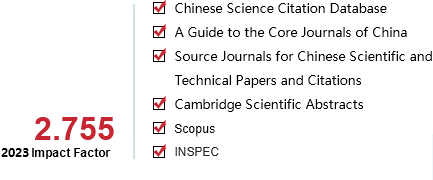[1]LI Wei,QIAO Junfei,HAN Honggui,et al.Computing and performance analysis of similarity between fuzzy rules[J].CAAI Transactions on Intelligent Systems,2017,12(1):124-131.[doi:10.11992/tis.201512040]
Copy
Computing and performance analysis of similarity between fuzzy rules
CAAI Transactions on Intelligent Systems[ISSN 1673-4785/CN 23-1538/TP] Volume:
12
Number of periods:
2017 1
Page number:
124-131
Column:
学术论文—机器学习
Public date:
2017-02-25
- Title:
- Computing and performance analysis of similarity between fuzzy rules
- Keywords:
- fuzzy rules; similarity computing; distinguishability; dimension dependency; computing complexity
- CLC:
- TP18
- DOI:
- 10.11992/tis.201512040
- Abstract:
- Facing the weaknesses of the existing analysis and computing methods for the similarity between fuzzy rules (FRs), this paper investigated the computing methods for the similarity between FRs. First, the similarity between FSs was transferred equivalently into the similarity between multivariable fuzzy sets, and then three application based performance criterions-distinguishability, dimension dependency, and computing complexity were proposed to evaluate the computing methods of the similarity between FRs. Second, four new methods were proposed based on the two existing methods for computing the similarity between FRs, and then the performance analysis and comparison between these new and existing methods were performed. Next, a simulation example for the similarity computing between FRs was provided, and the simulation shows effectiveness of the proposed performance criteria, feasibility of the computing methods, and correctness of the analysis conclusions. The results obtained in this paper provide powerful tools and guides for the similarity analysis and computing of FRs. Inparticular, they establish the methodological foundation and provide a new design approach for the merging of similar FRs in the structure simplification of fuzzy systems and fuzzy neural networks.
- References:
-
[1] ZADEH L A. Fuzzy sets[J]. Information and control, 1965, 8(3): 338-353.
[2] TüRKSEN I B, FAZEL ZARANDI M H. Fuzzy system models for aggregate scheduling analysis[J]. International Journal of approximate reasoning, 1998, 19(1/2): 119-143.
[3] FAY A. A fuzzy knowledge-based system for railway traffic control[J]. Engineering applications of artificial intelligence, 2000, 13(6): 719-729.
[4] GE Aaidong, WANG Yuzhen, WEI Airong, et al. Control design for multi-variable fuzzy systems with application to parallel hybrid electric vehicles[J]. Control theory & applications, 2013, 30(8): 998-1004.
[5] CHAO C T, CHEN Y J, TENG C C. Simplification of fuzzy-neural systems using similarity analysis[J]. IEEE transactions on systems, man, and cybernetics, part B (cybernetics), 1996, 26(2): 344-354.
[6] CHEN Minyou, LINKENS D A. Rule-base self-generation and simplification for data-driven fuzzy models[J]. Fuzzy sets and systems, 2004, 142(2): 243-265.
[7] TSEKOURAS G E. Fuzzy rule base simplification using multidimensional scaling and constrained optimization[J]. Fuzzy sets and systems, 2016, 297: 46-72.
[8] SETNES M, BABUSKA R, KAYMAK U, et al. Similarity measures in fuzzy rule base simplification[J]. IEEE transactions on systems, man, and cybernetics, part B (cybernetics), 1998, 28(3): 376-386.
[9] REZAEE B. Rule base simplification by using a similarity measure of fuzzy sets[J]. Journal of intelligent & fuzzy systems: applications in engineering and technology, 2012, 23(5): 193-201.
[10] PRATAMA M, ANAVATTI S G, LUGHOFER E. GENEFIS: toward an effective localist network[J]. IEEE transactions on fuzzy systems, 2014, 22(3): 547-562.
[11] LIN C T, LEE C S G. Reinforcement structure/parameter learning for neural-network-based fuzzy logic control systems[J]. IEEE transactions on fuzzy systems, 1994, 2(1): 46-63.
[12] LENG Gang, ZENG Xiaojun, KEANE J A. A hybrid learning algorithm with a similarity-based pruning strategy for self-adaptive neuro-fuzzy systems[J]. Applied soft computing, 2009, 9(4): 1354-1366.
[13] HAN Honggui, QIAO Junfei. A self-organizing fuzzy neural network based on a growing-and-pruning algorithm[J]. IEEE transactions on fuzzy systems, 2010, 18(6): 1129-1143.
[14] WANG Xiaojing, ZOU Zhihong, ZOU Hui. Water quality evaluation of Haihe River with fuzzy similarity measure methods[J]. Journal of environmental sciences, 2013, 25(10): 2041-2046.
[15] NGUYEN N N, ZHOU W J, QUEK C. GSETSK: a generic self-evolving TSK fuzzy neural network with a novel Hebbian-based rule reduction approach[J]. Applied soft computing, 2015, 35: 29-42.
[16] ROUBENS M. Pattern classification problems and fuzzy sets[J]. Fuzzy sets and systems, 1978, 1(4): 239-253.
[17] DENG Yong, SHI Wenkang, DU Feng, et al. A new similarity measure of generalized fuzzy numbers and its application to pattern recognition[J]. Pattern recognition letters, 2004, 25(8): 875-883.
[18] CASTELLANO G, FANELLI A M, MENCAR C, et al. Similarity-based Fuzzy clustering for user profiling[C]//Proceedings of 2007 IEEE/WIC/ACM International Conferences on Web Intelligence and Intelligent Agent Technology Workshops. Silicon Valley, USA, 2007: 75-78.
[19] QIAO Junfei, LI Wei, ZENG Xiaojun, et al. Identification of fuzzy neural networks by forward recursive input-output clustering and accurate similarity analysis[J]. Applied soft computing, 2016, 49: 524-543.
[20] LI Wei, QIAO Junfei, ZENG Xiaojun. Accurate similarity analysis and computing of Gaussian membership functions for FNN simplification[C]//Proceedings of the 12th International Conference on Fuzzy Systems and Knowledge Discovery. Zhangjiajie, China, 2015: 402-409.
- Similar References:
Memo
-
Last Update:
1900-01-01
